Organizational Behavior and Strategy in the Oil and Gas Industry
VerifiedAdded on 2022/10/31
|11
|3091
|293
Report
AI Summary
This report provides a comprehensive analysis of the oil and gas industry, examining how technological innovations drive corporate growth strategies. It delves into why some firms successfully adopt emerging technologies and expand their market share, while others stagnate and decline. The report explores the ways in which technological innovations are shaping the organization of the sector, considering factors such as exploration, extraction, refining, and marketing of petroleum products. It also addresses management factors that impact a firm's ability to enhance productivity and organizational design within the industry. The analysis includes the dynamics of the oil and gas industry over time, highlighting its evolution and the impact of technological advancements, such as artificial intelligence and digital technologies, on the industry's efficiency, competitiveness, and overall growth. The report also discusses the challenges faced by companies in adapting to these innovations and the importance of investment in new technologies for future success. The report leverages case studies and industry insights to support its findings, emphasizing the role of technology in shaping operations, offerings, and unlocking resources within the oil and gas sector.
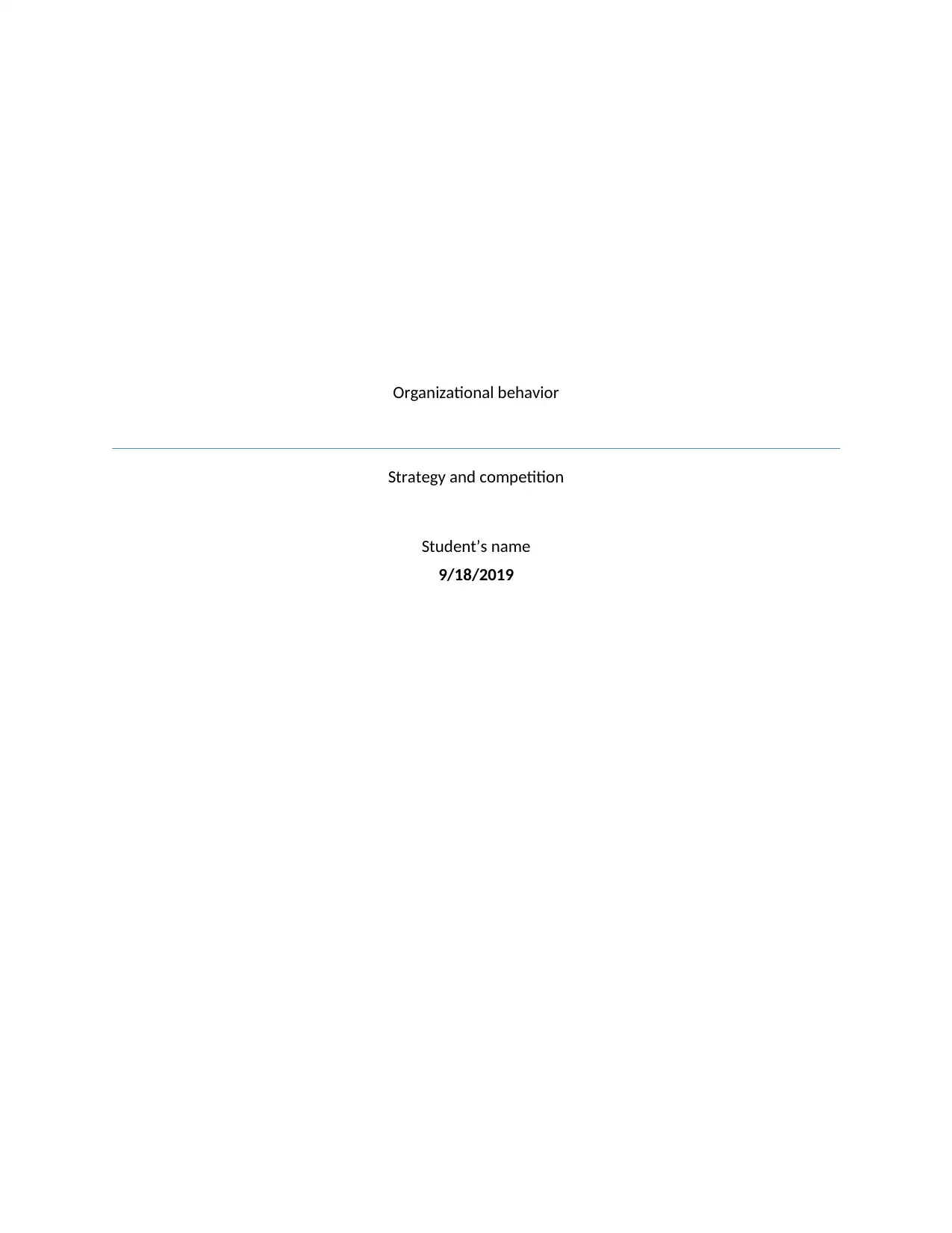
Organizational behavior
Strategy and competition
Student’s name
9/18/2019
Strategy and competition
Student’s name
9/18/2019
Paraphrase This Document
Need a fresh take? Get an instant paraphrase of this document with our AI Paraphraser
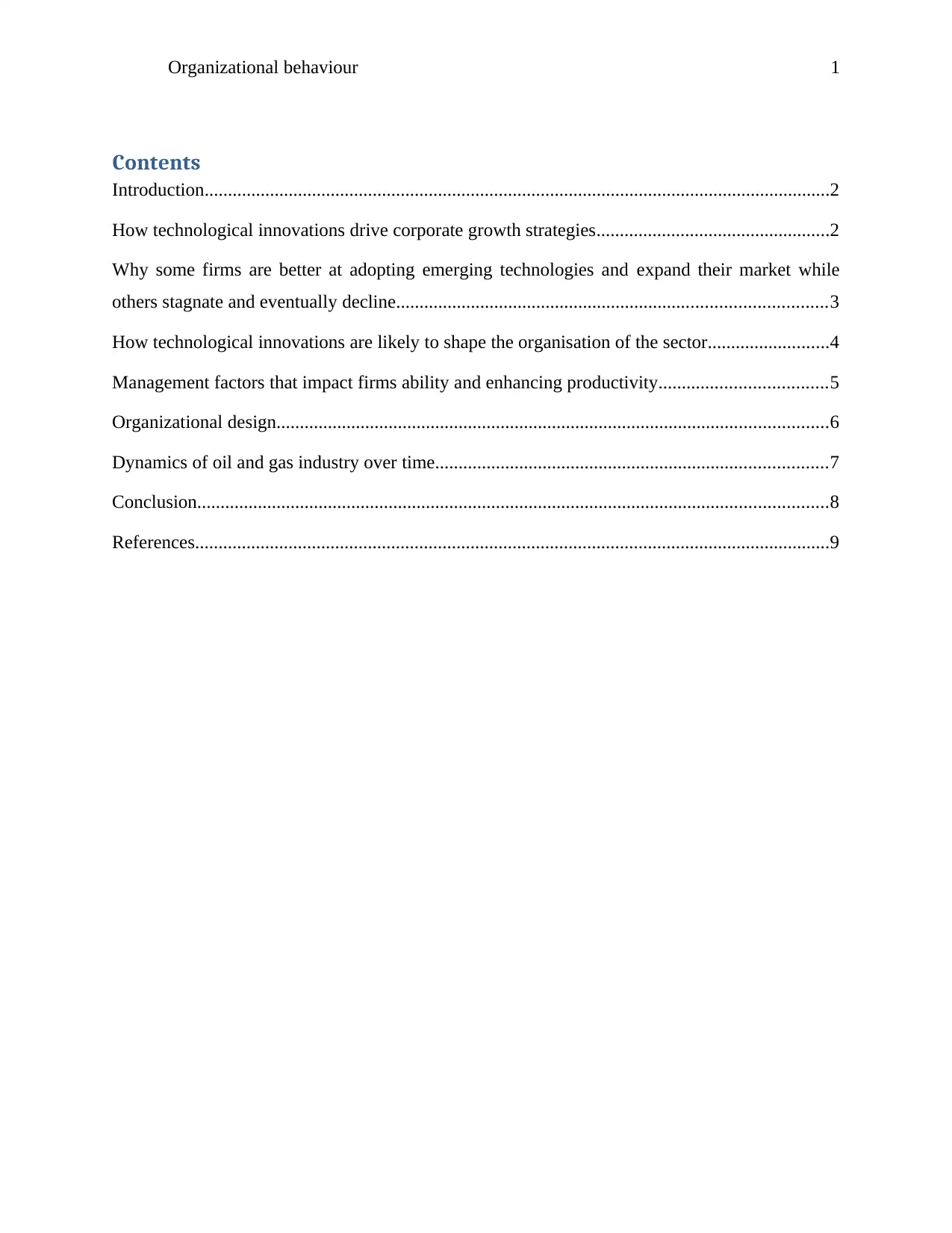
Organizational behaviour 1
Contents
Introduction......................................................................................................................................2
How technological innovations drive corporate growth strategies..................................................2
Why some firms are better at adopting emerging technologies and expand their market while
others stagnate and eventually decline............................................................................................3
How technological innovations are likely to shape the organisation of the sector..........................4
Management factors that impact firms ability and enhancing productivity....................................5
Organizational design......................................................................................................................6
Dynamics of oil and gas industry over time....................................................................................7
Conclusion.......................................................................................................................................8
References........................................................................................................................................9
Contents
Introduction......................................................................................................................................2
How technological innovations drive corporate growth strategies..................................................2
Why some firms are better at adopting emerging technologies and expand their market while
others stagnate and eventually decline............................................................................................3
How technological innovations are likely to shape the organisation of the sector..........................4
Management factors that impact firms ability and enhancing productivity....................................5
Organizational design......................................................................................................................6
Dynamics of oil and gas industry over time....................................................................................7
Conclusion.......................................................................................................................................8
References........................................................................................................................................9
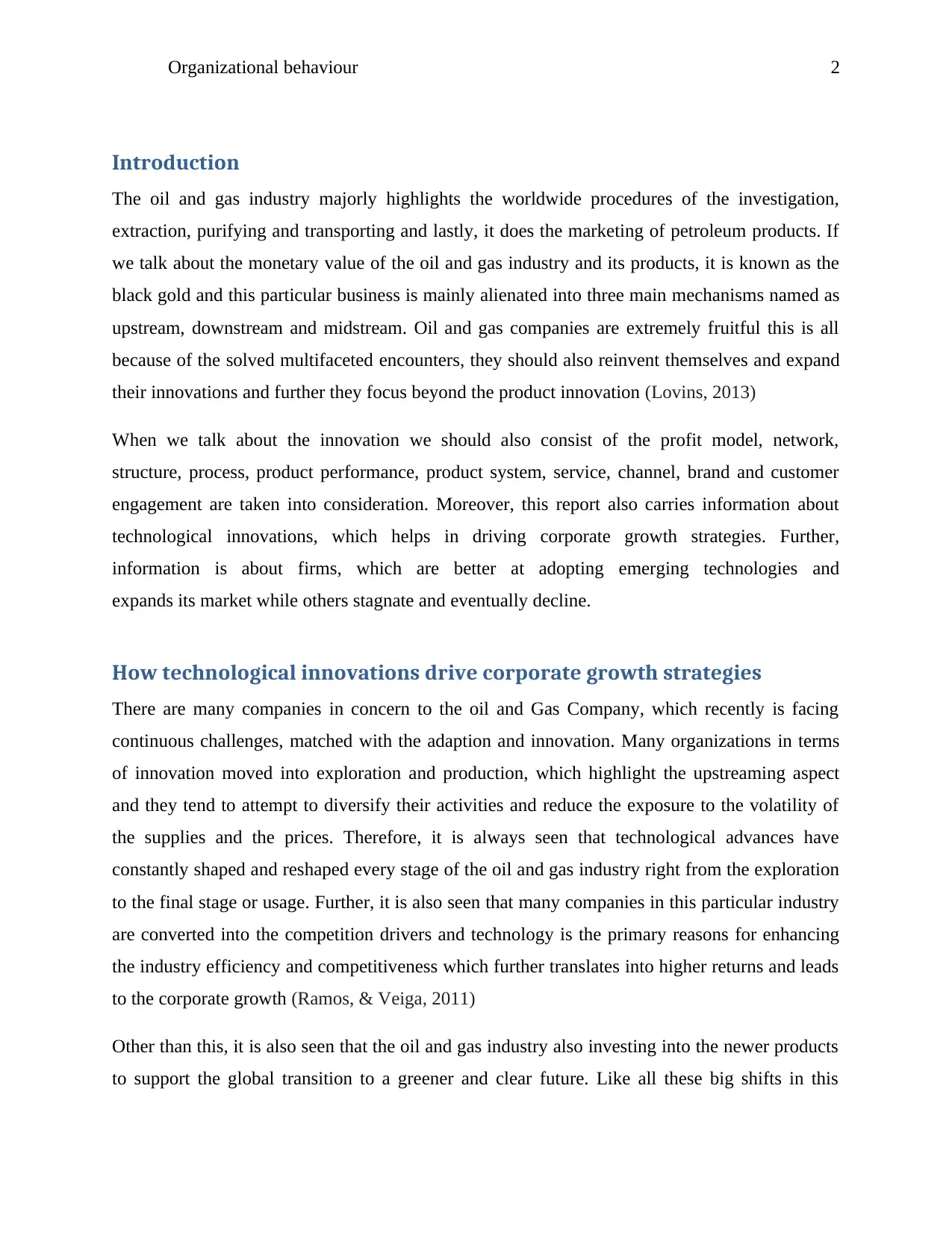
Organizational behaviour 2
Introduction
The oil and gas industry majorly highlights the worldwide procedures of the investigation,
extraction, purifying and transporting and lastly, it does the marketing of petroleum products. If
we talk about the monetary value of the oil and gas industry and its products, it is known as the
black gold and this particular business is mainly alienated into three main mechanisms named as
upstream, downstream and midstream. Oil and gas companies are extremely fruitful this is all
because of the solved multifaceted encounters, they should also reinvent themselves and expand
their innovations and further they focus beyond the product innovation (Lovins, 2013)
When we talk about the innovation we should also consist of the profit model, network,
structure, process, product performance, product system, service, channel, brand and customer
engagement are taken into consideration. Moreover, this report also carries information about
technological innovations, which helps in driving corporate growth strategies. Further,
information is about firms, which are better at adopting emerging technologies and
expands its market while others stagnate and eventually decline.
How technological innovations drive corporate growth strategies
There are many companies in concern to the oil and Gas Company, which recently is facing
continuous challenges, matched with the adaption and innovation. Many organizations in terms
of innovation moved into exploration and production, which highlight the upstreaming aspect
and they tend to attempt to diversify their activities and reduce the exposure to the volatility of
the supplies and the prices. Therefore, it is always seen that technological advances have
constantly shaped and reshaped every stage of the oil and gas industry right from the exploration
to the final stage or usage. Further, it is also seen that many companies in this particular industry
are converted into the competition drivers and technology is the primary reasons for enhancing
the industry efficiency and competitiveness which further translates into higher returns and leads
to the corporate growth (Ramos, & Veiga, 2011)
Other than this, it is also seen that the oil and gas industry also investing into the newer products
to support the global transition to a greener and clear future. Like all these big shifts in this
Introduction
The oil and gas industry majorly highlights the worldwide procedures of the investigation,
extraction, purifying and transporting and lastly, it does the marketing of petroleum products. If
we talk about the monetary value of the oil and gas industry and its products, it is known as the
black gold and this particular business is mainly alienated into three main mechanisms named as
upstream, downstream and midstream. Oil and gas companies are extremely fruitful this is all
because of the solved multifaceted encounters, they should also reinvent themselves and expand
their innovations and further they focus beyond the product innovation (Lovins, 2013)
When we talk about the innovation we should also consist of the profit model, network,
structure, process, product performance, product system, service, channel, brand and customer
engagement are taken into consideration. Moreover, this report also carries information about
technological innovations, which helps in driving corporate growth strategies. Further,
information is about firms, which are better at adopting emerging technologies and
expands its market while others stagnate and eventually decline.
How technological innovations drive corporate growth strategies
There are many companies in concern to the oil and Gas Company, which recently is facing
continuous challenges, matched with the adaption and innovation. Many organizations in terms
of innovation moved into exploration and production, which highlight the upstreaming aspect
and they tend to attempt to diversify their activities and reduce the exposure to the volatility of
the supplies and the prices. Therefore, it is always seen that technological advances have
constantly shaped and reshaped every stage of the oil and gas industry right from the exploration
to the final stage or usage. Further, it is also seen that many companies in this particular industry
are converted into the competition drivers and technology is the primary reasons for enhancing
the industry efficiency and competitiveness which further translates into higher returns and leads
to the corporate growth (Ramos, & Veiga, 2011)
Other than this, it is also seen that the oil and gas industry also investing into the newer products
to support the global transition to a greener and clear future. Like all these big shifts in this
⊘ This is a preview!⊘
Do you want full access?
Subscribe today to unlock all pages.

Trusted by 1+ million students worldwide
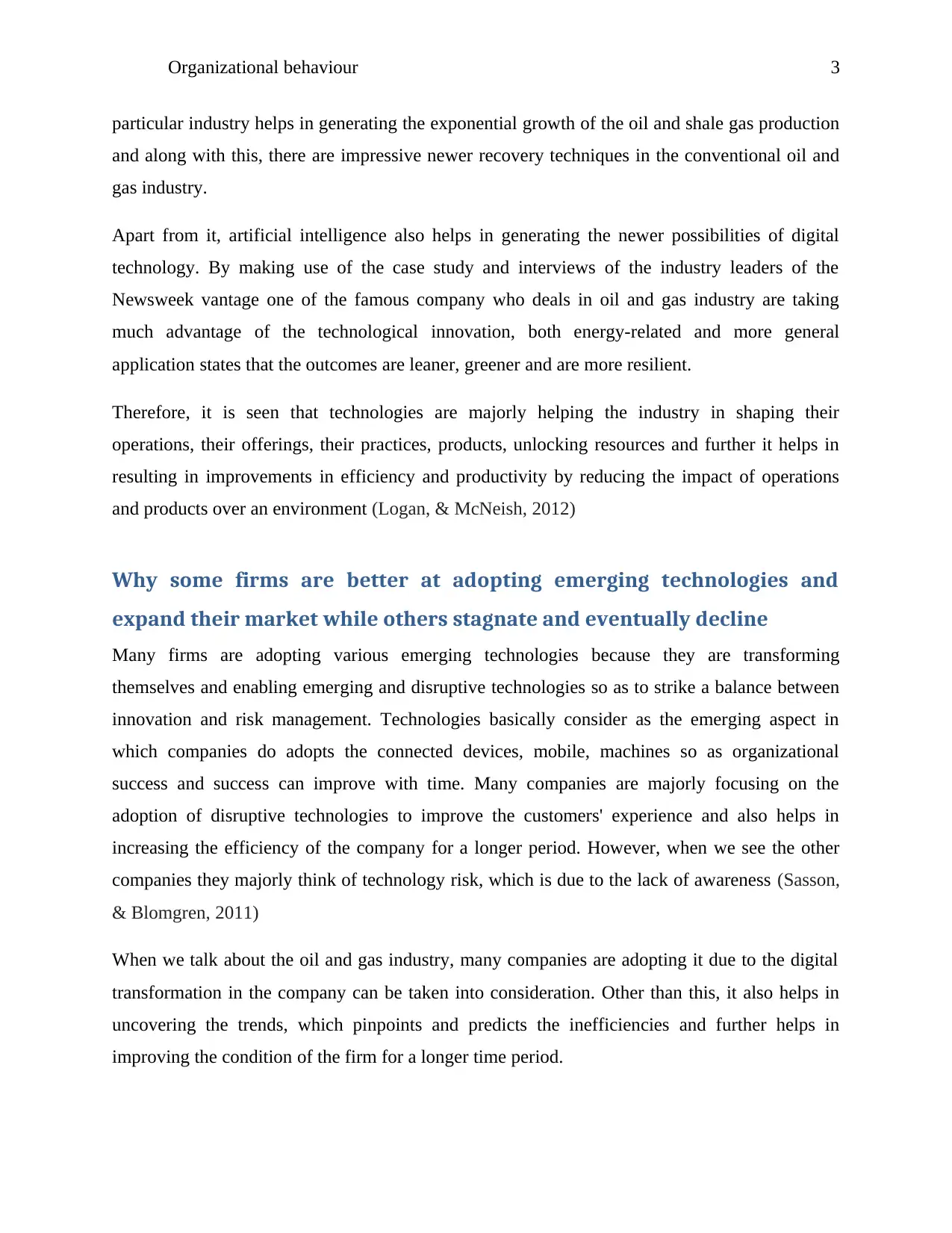
Organizational behaviour 3
particular industry helps in generating the exponential growth of the oil and shale gas production
and along with this, there are impressive newer recovery techniques in the conventional oil and
gas industry.
Apart from it, artificial intelligence also helps in generating the newer possibilities of digital
technology. By making use of the case study and interviews of the industry leaders of the
Newsweek vantage one of the famous company who deals in oil and gas industry are taking
much advantage of the technological innovation, both energy-related and more general
application states that the outcomes are leaner, greener and are more resilient.
Therefore, it is seen that technologies are majorly helping the industry in shaping their
operations, their offerings, their practices, products, unlocking resources and further it helps in
resulting in improvements in efficiency and productivity by reducing the impact of operations
and products over an environment (Logan, & McNeish, 2012)
Why some firms are better at adopting emerging technologies and
expand their market while others stagnate and eventually decline
Many firms are adopting various emerging technologies because they are transforming
themselves and enabling emerging and disruptive technologies so as to strike a balance between
innovation and risk management. Technologies basically consider as the emerging aspect in
which companies do adopts the connected devices, mobile, machines so as organizational
success and success can improve with time. Many companies are majorly focusing on the
adoption of disruptive technologies to improve the customers' experience and also helps in
increasing the efficiency of the company for a longer period. However, when we see the other
companies they majorly think of technology risk, which is due to the lack of awareness (Sasson,
& Blomgren, 2011)
When we talk about the oil and gas industry, many companies are adopting it due to the digital
transformation in the company can be taken into consideration. Other than this, it also helps in
uncovering the trends, which pinpoints and predicts the inefficiencies and further helps in
improving the condition of the firm for a longer time period.
particular industry helps in generating the exponential growth of the oil and shale gas production
and along with this, there are impressive newer recovery techniques in the conventional oil and
gas industry.
Apart from it, artificial intelligence also helps in generating the newer possibilities of digital
technology. By making use of the case study and interviews of the industry leaders of the
Newsweek vantage one of the famous company who deals in oil and gas industry are taking
much advantage of the technological innovation, both energy-related and more general
application states that the outcomes are leaner, greener and are more resilient.
Therefore, it is seen that technologies are majorly helping the industry in shaping their
operations, their offerings, their practices, products, unlocking resources and further it helps in
resulting in improvements in efficiency and productivity by reducing the impact of operations
and products over an environment (Logan, & McNeish, 2012)
Why some firms are better at adopting emerging technologies and
expand their market while others stagnate and eventually decline
Many firms are adopting various emerging technologies because they are transforming
themselves and enabling emerging and disruptive technologies so as to strike a balance between
innovation and risk management. Technologies basically consider as the emerging aspect in
which companies do adopts the connected devices, mobile, machines so as organizational
success and success can improve with time. Many companies are majorly focusing on the
adoption of disruptive technologies to improve the customers' experience and also helps in
increasing the efficiency of the company for a longer period. However, when we see the other
companies they majorly think of technology risk, which is due to the lack of awareness (Sasson,
& Blomgren, 2011)
When we talk about the oil and gas industry, many companies are adopting it due to the digital
transformation in the company can be taken into consideration. Other than this, it also helps in
uncovering the trends, which pinpoints and predicts the inefficiencies and further helps in
improving the condition of the firm for a longer time period.
Paraphrase This Document
Need a fresh take? Get an instant paraphrase of this document with our AI Paraphraser
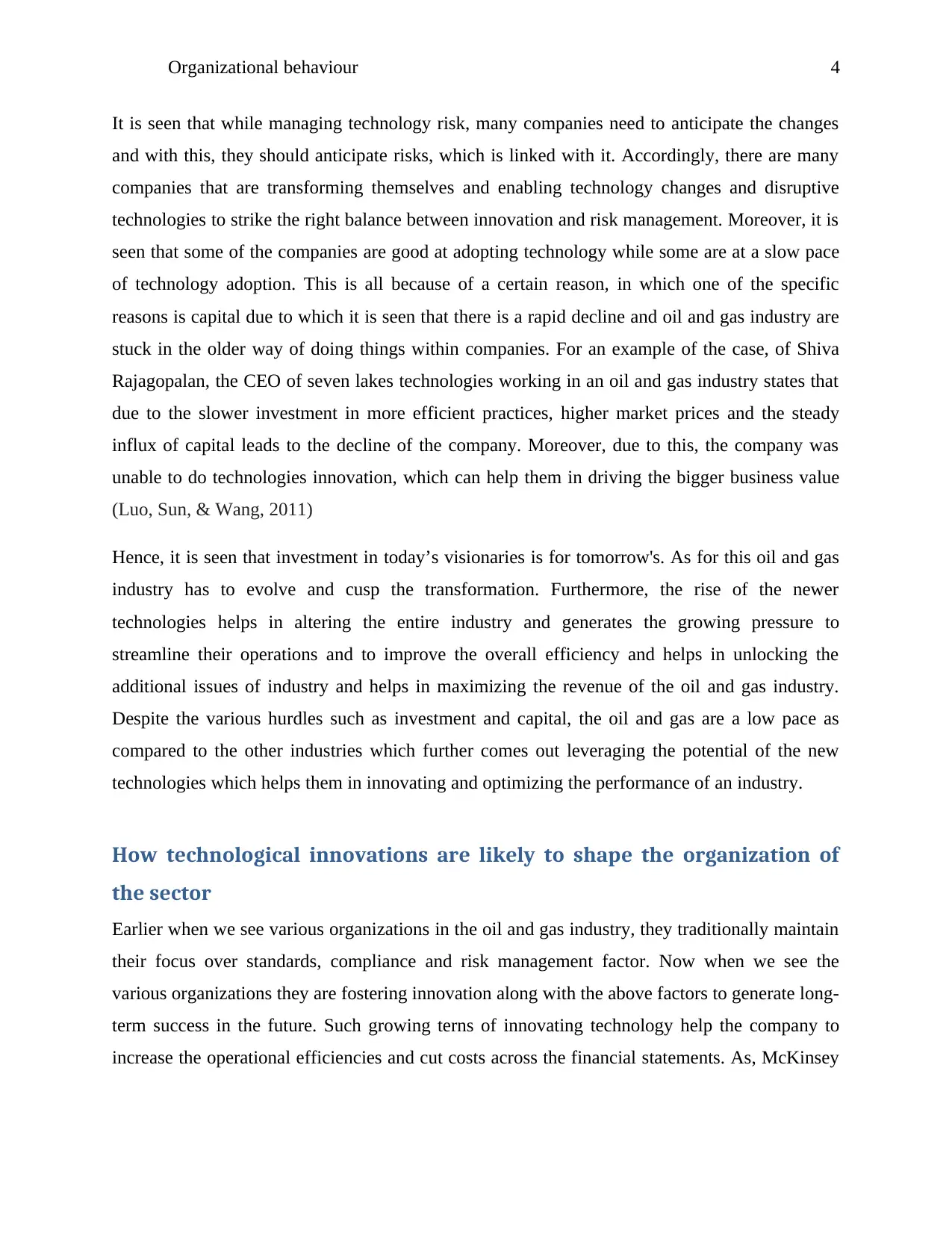
Organizational behaviour 4
It is seen that while managing technology risk, many companies need to anticipate the changes
and with this, they should anticipate risks, which is linked with it. Accordingly, there are many
companies that are transforming themselves and enabling technology changes and disruptive
technologies to strike the right balance between innovation and risk management. Moreover, it is
seen that some of the companies are good at adopting technology while some are at a slow pace
of technology adoption. This is all because of a certain reason, in which one of the specific
reasons is capital due to which it is seen that there is a rapid decline and oil and gas industry are
stuck in the older way of doing things within companies. For an example of the case, of Shiva
Rajagopalan, the CEO of seven lakes technologies working in an oil and gas industry states that
due to the slower investment in more efficient practices, higher market prices and the steady
influx of capital leads to the decline of the company. Moreover, due to this, the company was
unable to do technologies innovation, which can help them in driving the bigger business value
(Luo, Sun, & Wang, 2011)
Hence, it is seen that investment in today’s visionaries is for tomorrow's. As for this oil and gas
industry has to evolve and cusp the transformation. Furthermore, the rise of the newer
technologies helps in altering the entire industry and generates the growing pressure to
streamline their operations and to improve the overall efficiency and helps in unlocking the
additional issues of industry and helps in maximizing the revenue of the oil and gas industry.
Despite the various hurdles such as investment and capital, the oil and gas are a low pace as
compared to the other industries which further comes out leveraging the potential of the new
technologies which helps them in innovating and optimizing the performance of an industry.
How technological innovations are likely to shape the organization of
the sector
Earlier when we see various organizations in the oil and gas industry, they traditionally maintain
their focus over standards, compliance and risk management factor. Now when we see the
various organizations they are fostering innovation along with the above factors to generate long-
term success in the future. Such growing terns of innovating technology help the company to
increase the operational efficiencies and cut costs across the financial statements. As, McKinsey
It is seen that while managing technology risk, many companies need to anticipate the changes
and with this, they should anticipate risks, which is linked with it. Accordingly, there are many
companies that are transforming themselves and enabling technology changes and disruptive
technologies to strike the right balance between innovation and risk management. Moreover, it is
seen that some of the companies are good at adopting technology while some are at a slow pace
of technology adoption. This is all because of a certain reason, in which one of the specific
reasons is capital due to which it is seen that there is a rapid decline and oil and gas industry are
stuck in the older way of doing things within companies. For an example of the case, of Shiva
Rajagopalan, the CEO of seven lakes technologies working in an oil and gas industry states that
due to the slower investment in more efficient practices, higher market prices and the steady
influx of capital leads to the decline of the company. Moreover, due to this, the company was
unable to do technologies innovation, which can help them in driving the bigger business value
(Luo, Sun, & Wang, 2011)
Hence, it is seen that investment in today’s visionaries is for tomorrow's. As for this oil and gas
industry has to evolve and cusp the transformation. Furthermore, the rise of the newer
technologies helps in altering the entire industry and generates the growing pressure to
streamline their operations and to improve the overall efficiency and helps in unlocking the
additional issues of industry and helps in maximizing the revenue of the oil and gas industry.
Despite the various hurdles such as investment and capital, the oil and gas are a low pace as
compared to the other industries which further comes out leveraging the potential of the new
technologies which helps them in innovating and optimizing the performance of an industry.
How technological innovations are likely to shape the organization of
the sector
Earlier when we see various organizations in the oil and gas industry, they traditionally maintain
their focus over standards, compliance and risk management factor. Now when we see the
various organizations they are fostering innovation along with the above factors to generate long-
term success in the future. Such growing terns of innovating technology help the company to
increase the operational efficiencies and cut costs across the financial statements. As, McKinsey
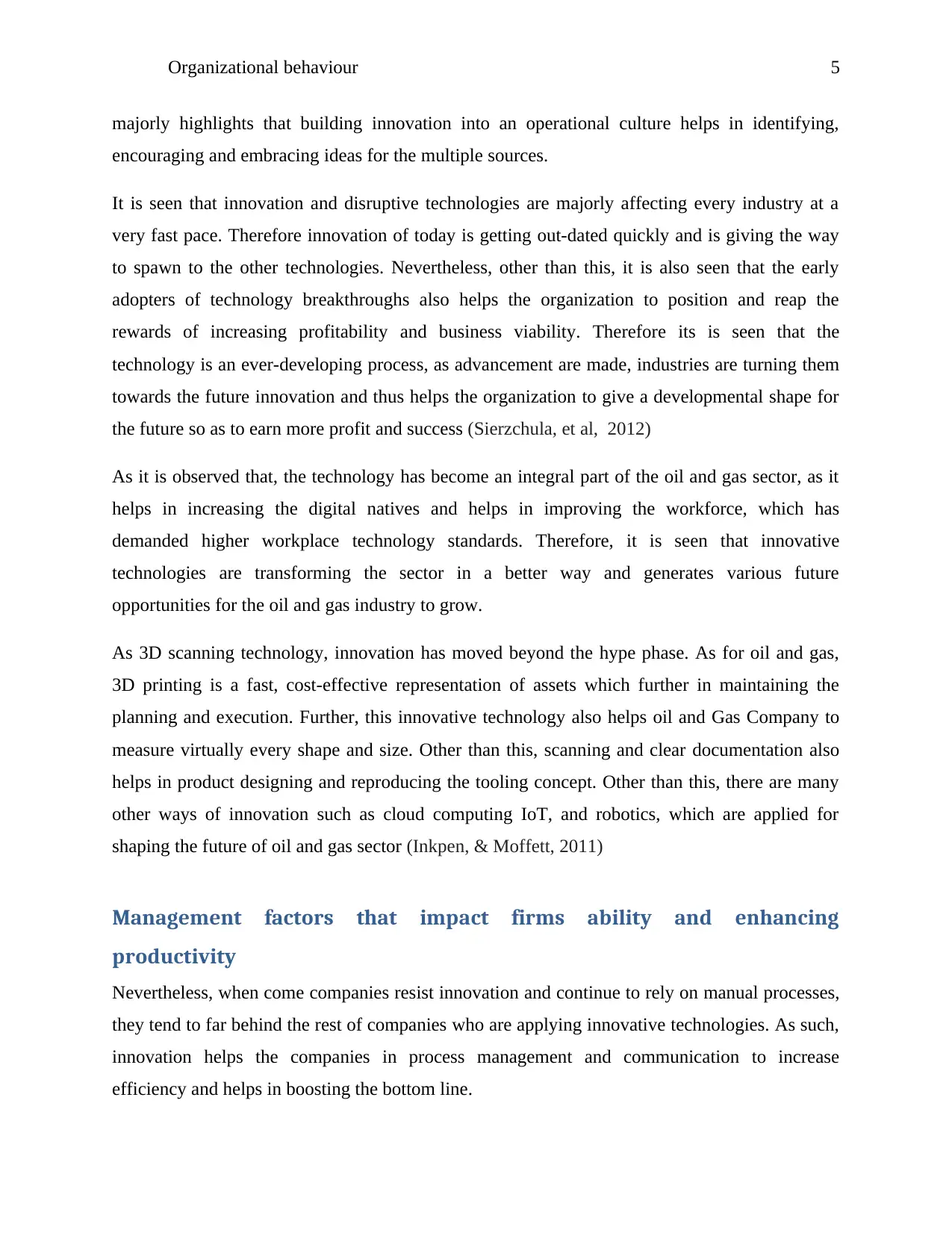
Organizational behaviour 5
majorly highlights that building innovation into an operational culture helps in identifying,
encouraging and embracing ideas for the multiple sources.
It is seen that innovation and disruptive technologies are majorly affecting every industry at a
very fast pace. Therefore innovation of today is getting out-dated quickly and is giving the way
to spawn to the other technologies. Nevertheless, other than this, it is also seen that the early
adopters of technology breakthroughs also helps the organization to position and reap the
rewards of increasing profitability and business viability. Therefore its is seen that the
technology is an ever-developing process, as advancement are made, industries are turning them
towards the future innovation and thus helps the organization to give a developmental shape for
the future so as to earn more profit and success (Sierzchula, et al, 2012)
As it is observed that, the technology has become an integral part of the oil and gas sector, as it
helps in increasing the digital natives and helps in improving the workforce, which has
demanded higher workplace technology standards. Therefore, it is seen that innovative
technologies are transforming the sector in a better way and generates various future
opportunities for the oil and gas industry to grow.
As 3D scanning technology, innovation has moved beyond the hype phase. As for oil and gas,
3D printing is a fast, cost-effective representation of assets which further in maintaining the
planning and execution. Further, this innovative technology also helps oil and Gas Company to
measure virtually every shape and size. Other than this, scanning and clear documentation also
helps in product designing and reproducing the tooling concept. Other than this, there are many
other ways of innovation such as cloud computing IoT, and robotics, which are applied for
shaping the future of oil and gas sector (Inkpen, & Moffett, 2011)
Management factors that impact firms ability and enhancing
productivity
Nevertheless, when come companies resist innovation and continue to rely on manual processes,
they tend to far behind the rest of companies who are applying innovative technologies. As such,
innovation helps the companies in process management and communication to increase
efficiency and helps in boosting the bottom line.
majorly highlights that building innovation into an operational culture helps in identifying,
encouraging and embracing ideas for the multiple sources.
It is seen that innovation and disruptive technologies are majorly affecting every industry at a
very fast pace. Therefore innovation of today is getting out-dated quickly and is giving the way
to spawn to the other technologies. Nevertheless, other than this, it is also seen that the early
adopters of technology breakthroughs also helps the organization to position and reap the
rewards of increasing profitability and business viability. Therefore its is seen that the
technology is an ever-developing process, as advancement are made, industries are turning them
towards the future innovation and thus helps the organization to give a developmental shape for
the future so as to earn more profit and success (Sierzchula, et al, 2012)
As it is observed that, the technology has become an integral part of the oil and gas sector, as it
helps in increasing the digital natives and helps in improving the workforce, which has
demanded higher workplace technology standards. Therefore, it is seen that innovative
technologies are transforming the sector in a better way and generates various future
opportunities for the oil and gas industry to grow.
As 3D scanning technology, innovation has moved beyond the hype phase. As for oil and gas,
3D printing is a fast, cost-effective representation of assets which further in maintaining the
planning and execution. Further, this innovative technology also helps oil and Gas Company to
measure virtually every shape and size. Other than this, scanning and clear documentation also
helps in product designing and reproducing the tooling concept. Other than this, there are many
other ways of innovation such as cloud computing IoT, and robotics, which are applied for
shaping the future of oil and gas sector (Inkpen, & Moffett, 2011)
Management factors that impact firms ability and enhancing
productivity
Nevertheless, when come companies resist innovation and continue to rely on manual processes,
they tend to far behind the rest of companies who are applying innovative technologies. As such,
innovation helps the companies in process management and communication to increase
efficiency and helps in boosting the bottom line.
⊘ This is a preview!⊘
Do you want full access?
Subscribe today to unlock all pages.

Trusted by 1+ million students worldwide
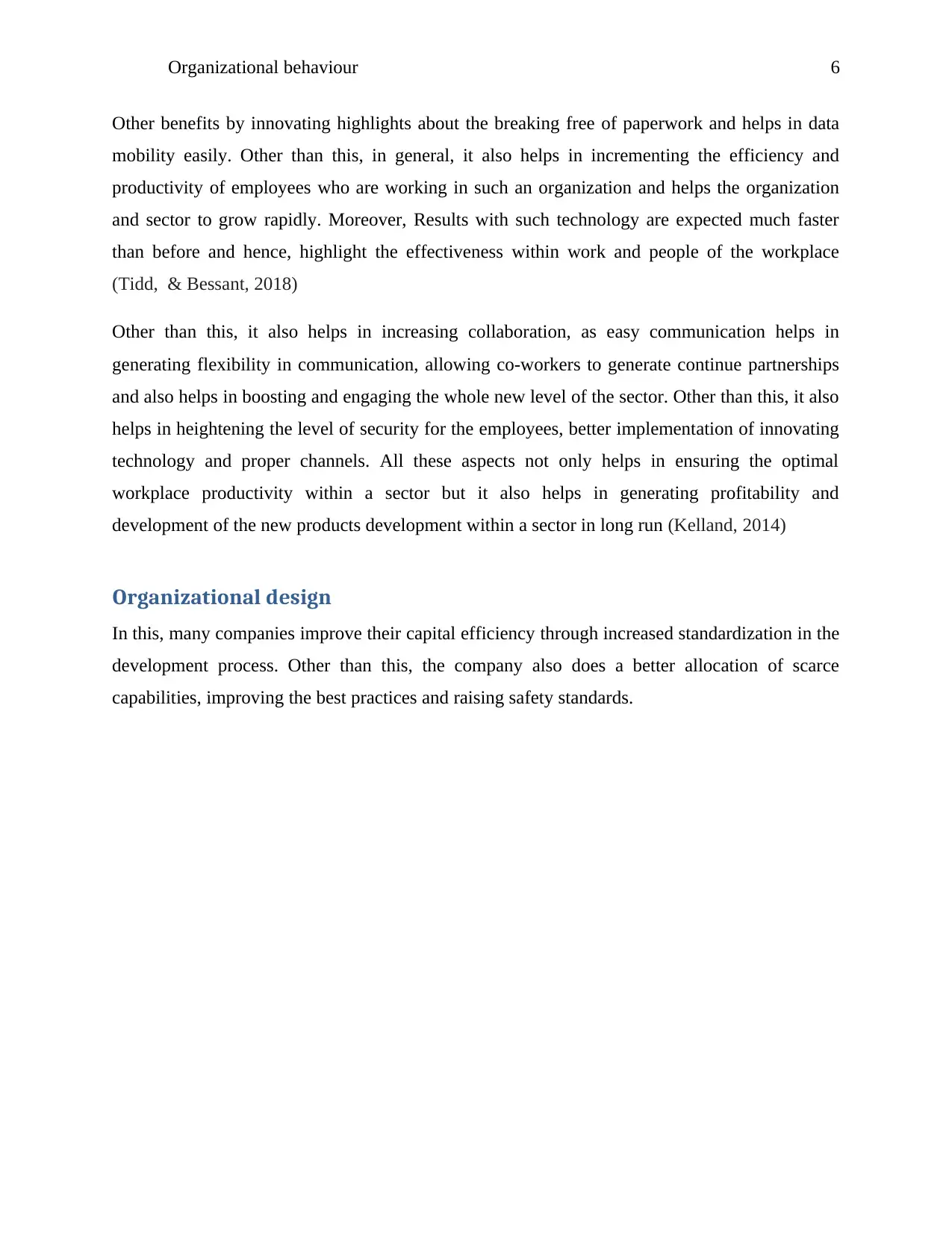
Organizational behaviour 6
Other benefits by innovating highlights about the breaking free of paperwork and helps in data
mobility easily. Other than this, in general, it also helps in incrementing the efficiency and
productivity of employees who are working in such an organization and helps the organization
and sector to grow rapidly. Moreover, Results with such technology are expected much faster
than before and hence, highlight the effectiveness within work and people of the workplace
(Tidd, & Bessant, 2018)
Other than this, it also helps in increasing collaboration, as easy communication helps in
generating flexibility in communication, allowing co-workers to generate continue partnerships
and also helps in boosting and engaging the whole new level of the sector. Other than this, it also
helps in heightening the level of security for the employees, better implementation of innovating
technology and proper channels. All these aspects not only helps in ensuring the optimal
workplace productivity within a sector but it also helps in generating profitability and
development of the new products development within a sector in long run (Kelland, 2014)
Organizational design
In this, many companies improve their capital efficiency through increased standardization in the
development process. Other than this, the company also does a better allocation of scarce
capabilities, improving the best practices and raising safety standards.
Other benefits by innovating highlights about the breaking free of paperwork and helps in data
mobility easily. Other than this, in general, it also helps in incrementing the efficiency and
productivity of employees who are working in such an organization and helps the organization
and sector to grow rapidly. Moreover, Results with such technology are expected much faster
than before and hence, highlight the effectiveness within work and people of the workplace
(Tidd, & Bessant, 2018)
Other than this, it also helps in increasing collaboration, as easy communication helps in
generating flexibility in communication, allowing co-workers to generate continue partnerships
and also helps in boosting and engaging the whole new level of the sector. Other than this, it also
helps in heightening the level of security for the employees, better implementation of innovating
technology and proper channels. All these aspects not only helps in ensuring the optimal
workplace productivity within a sector but it also helps in generating profitability and
development of the new products development within a sector in long run (Kelland, 2014)
Organizational design
In this, many companies improve their capital efficiency through increased standardization in the
development process. Other than this, the company also does a better allocation of scarce
capabilities, improving the best practices and raising safety standards.
Paraphrase This Document
Need a fresh take? Get an instant paraphrase of this document with our AI Paraphraser
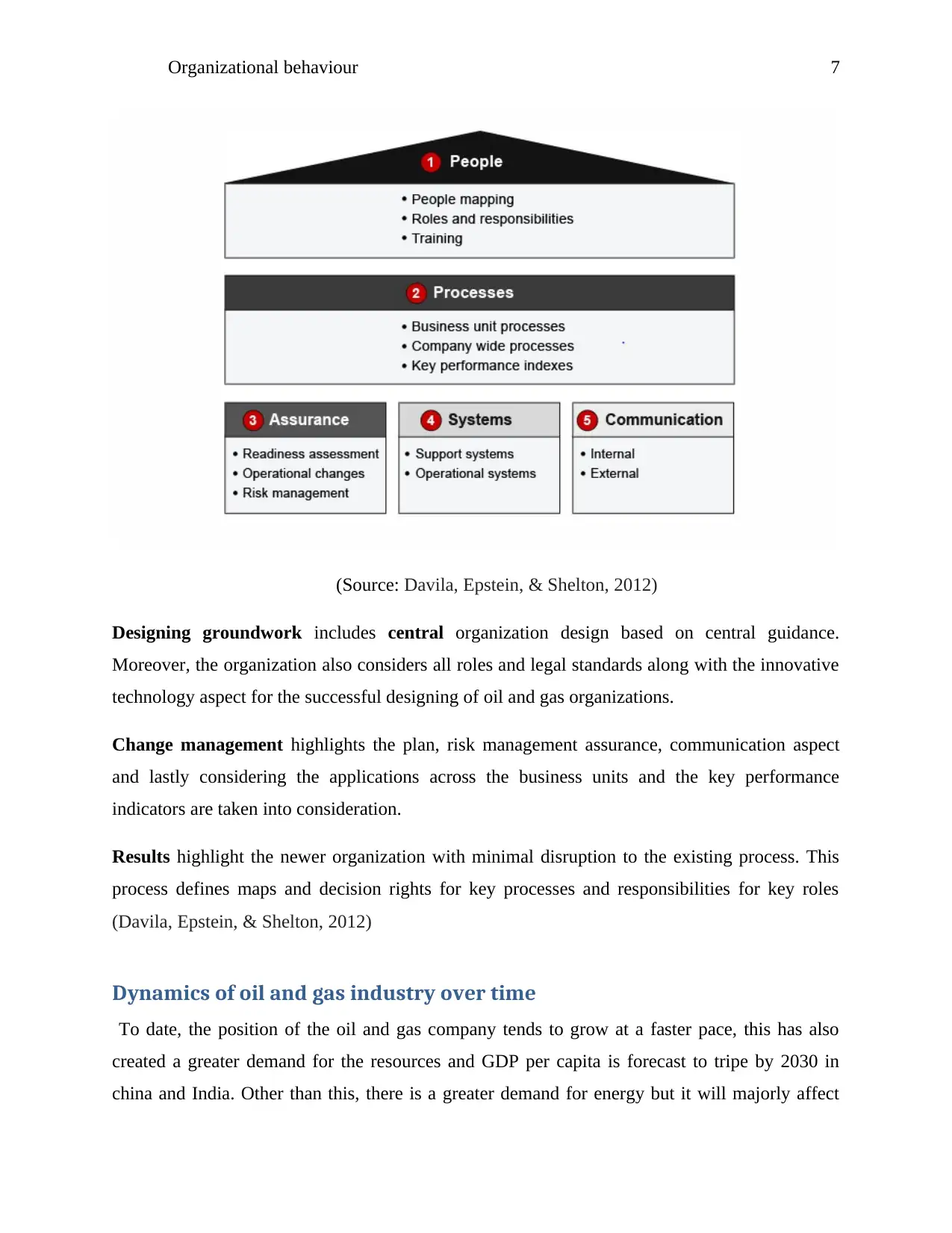
Organizational behaviour 7
(Source: Davila, Epstein, & Shelton, 2012)
Designing groundwork includes central organization design based on central guidance.
Moreover, the organization also considers all roles and legal standards along with the innovative
technology aspect for the successful designing of oil and gas organizations.
Change management highlights the plan, risk management assurance, communication aspect
and lastly considering the applications across the business units and the key performance
indicators are taken into consideration.
Results highlight the newer organization with minimal disruption to the existing process. This
process defines maps and decision rights for key processes and responsibilities for key roles
(Davila, Epstein, & Shelton, 2012)
Dynamics of oil and gas industry over time
To date, the position of the oil and gas company tends to grow at a faster pace, this has also
created a greater demand for the resources and GDP per capita is forecast to tripe by 2030 in
china and India. Other than this, there is a greater demand for energy but it will majorly affect
(Source: Davila, Epstein, & Shelton, 2012)
Designing groundwork includes central organization design based on central guidance.
Moreover, the organization also considers all roles and legal standards along with the innovative
technology aspect for the successful designing of oil and gas organizations.
Change management highlights the plan, risk management assurance, communication aspect
and lastly considering the applications across the business units and the key performance
indicators are taken into consideration.
Results highlight the newer organization with minimal disruption to the existing process. This
process defines maps and decision rights for key processes and responsibilities for key roles
(Davila, Epstein, & Shelton, 2012)
Dynamics of oil and gas industry over time
To date, the position of the oil and gas company tends to grow at a faster pace, this has also
created a greater demand for the resources and GDP per capita is forecast to tripe by 2030 in
china and India. Other than this, there is a greater demand for energy but it will majorly affect
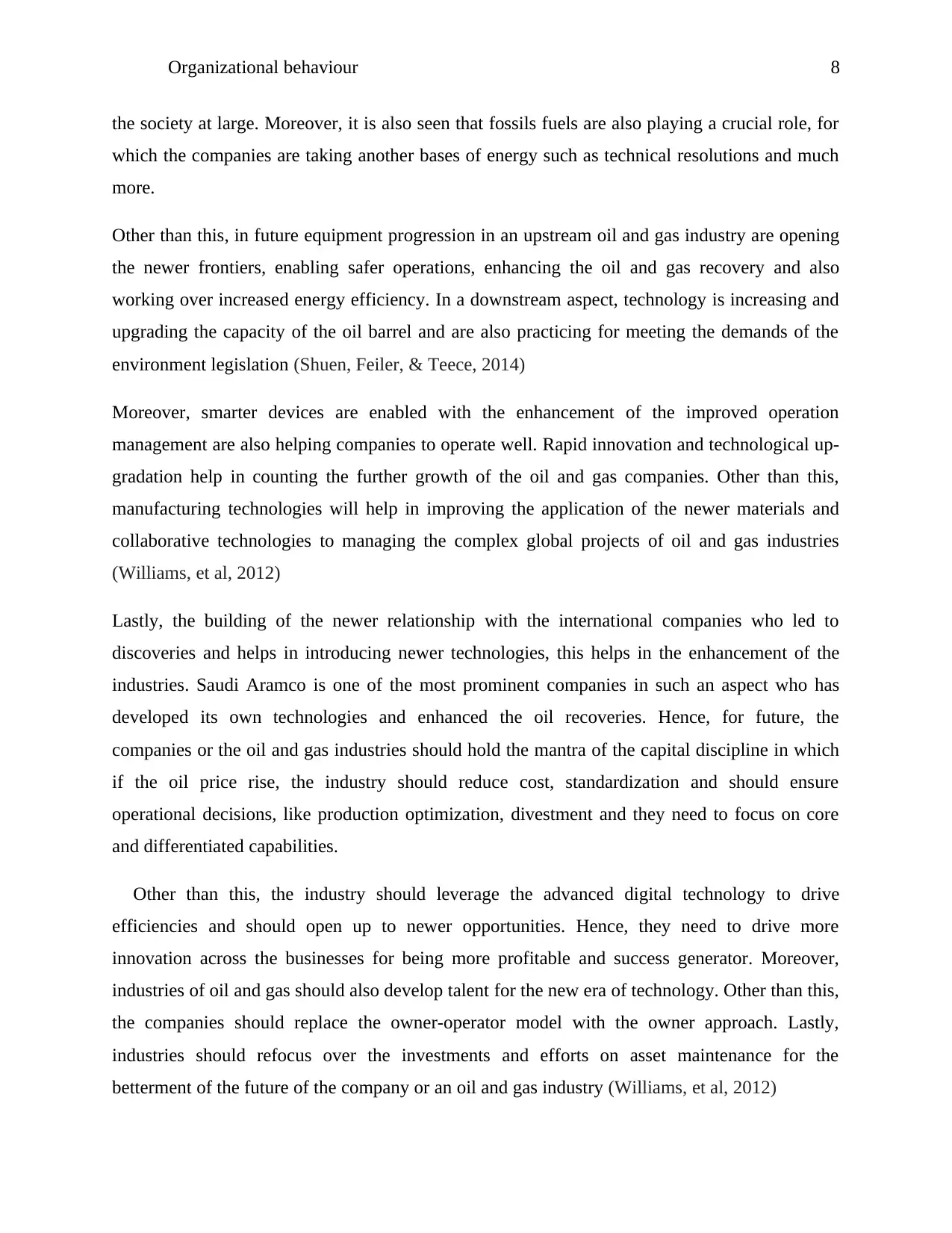
Organizational behaviour 8
the society at large. Moreover, it is also seen that fossils fuels are also playing a crucial role, for
which the companies are taking another bases of energy such as technical resolutions and much
more.
Other than this, in future equipment progression in an upstream oil and gas industry are opening
the newer frontiers, enabling safer operations, enhancing the oil and gas recovery and also
working over increased energy efficiency. In a downstream aspect, technology is increasing and
upgrading the capacity of the oil barrel and are also practicing for meeting the demands of the
environment legislation (Shuen, Feiler, & Teece, 2014)
Moreover, smarter devices are enabled with the enhancement of the improved operation
management are also helping companies to operate well. Rapid innovation and technological up-
gradation help in counting the further growth of the oil and gas companies. Other than this,
manufacturing technologies will help in improving the application of the newer materials and
collaborative technologies to managing the complex global projects of oil and gas industries
(Williams, et al, 2012)
Lastly, the building of the newer relationship with the international companies who led to
discoveries and helps in introducing newer technologies, this helps in the enhancement of the
industries. Saudi Aramco is one of the most prominent companies in such an aspect who has
developed its own technologies and enhanced the oil recoveries. Hence, for future, the
companies or the oil and gas industries should hold the mantra of the capital discipline in which
if the oil price rise, the industry should reduce cost, standardization and should ensure
operational decisions, like production optimization, divestment and they need to focus on core
and differentiated capabilities.
Other than this, the industry should leverage the advanced digital technology to drive
efficiencies and should open up to newer opportunities. Hence, they need to drive more
innovation across the businesses for being more profitable and success generator. Moreover,
industries of oil and gas should also develop talent for the new era of technology. Other than this,
the companies should replace the owner-operator model with the owner approach. Lastly,
industries should refocus over the investments and efforts on asset maintenance for the
betterment of the future of the company or an oil and gas industry (Williams, et al, 2012)
the society at large. Moreover, it is also seen that fossils fuels are also playing a crucial role, for
which the companies are taking another bases of energy such as technical resolutions and much
more.
Other than this, in future equipment progression in an upstream oil and gas industry are opening
the newer frontiers, enabling safer operations, enhancing the oil and gas recovery and also
working over increased energy efficiency. In a downstream aspect, technology is increasing and
upgrading the capacity of the oil barrel and are also practicing for meeting the demands of the
environment legislation (Shuen, Feiler, & Teece, 2014)
Moreover, smarter devices are enabled with the enhancement of the improved operation
management are also helping companies to operate well. Rapid innovation and technological up-
gradation help in counting the further growth of the oil and gas companies. Other than this,
manufacturing technologies will help in improving the application of the newer materials and
collaborative technologies to managing the complex global projects of oil and gas industries
(Williams, et al, 2012)
Lastly, the building of the newer relationship with the international companies who led to
discoveries and helps in introducing newer technologies, this helps in the enhancement of the
industries. Saudi Aramco is one of the most prominent companies in such an aspect who has
developed its own technologies and enhanced the oil recoveries. Hence, for future, the
companies or the oil and gas industries should hold the mantra of the capital discipline in which
if the oil price rise, the industry should reduce cost, standardization and should ensure
operational decisions, like production optimization, divestment and they need to focus on core
and differentiated capabilities.
Other than this, the industry should leverage the advanced digital technology to drive
efficiencies and should open up to newer opportunities. Hence, they need to drive more
innovation across the businesses for being more profitable and success generator. Moreover,
industries of oil and gas should also develop talent for the new era of technology. Other than this,
the companies should replace the owner-operator model with the owner approach. Lastly,
industries should refocus over the investments and efforts on asset maintenance for the
betterment of the future of the company or an oil and gas industry (Williams, et al, 2012)
⊘ This is a preview!⊘
Do you want full access?
Subscribe today to unlock all pages.

Trusted by 1+ million students worldwide
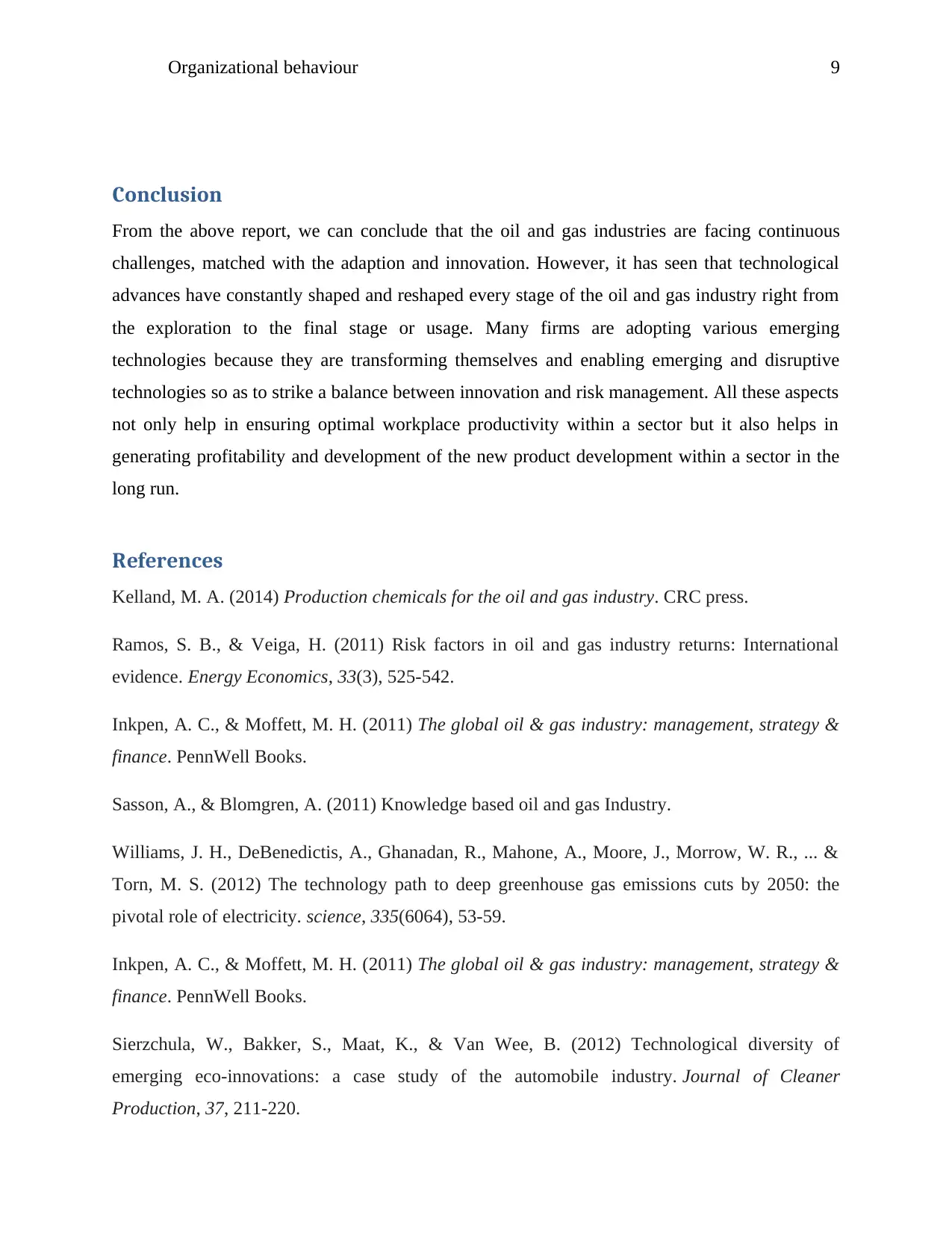
Organizational behaviour 9
Conclusion
From the above report, we can conclude that the oil and gas industries are facing continuous
challenges, matched with the adaption and innovation. However, it has seen that technological
advances have constantly shaped and reshaped every stage of the oil and gas industry right from
the exploration to the final stage or usage. Many firms are adopting various emerging
technologies because they are transforming themselves and enabling emerging and disruptive
technologies so as to strike a balance between innovation and risk management. All these aspects
not only help in ensuring optimal workplace productivity within a sector but it also helps in
generating profitability and development of the new product development within a sector in the
long run.
References
Kelland, M. A. (2014) Production chemicals for the oil and gas industry. CRC press.
Ramos, S. B., & Veiga, H. (2011) Risk factors in oil and gas industry returns: International
evidence. Energy Economics, 33(3), 525-542.
Inkpen, A. C., & Moffett, M. H. (2011) The global oil & gas industry: management, strategy &
finance. PennWell Books.
Sasson, A., & Blomgren, A. (2011) Knowledge based oil and gas Industry.
Williams, J. H., DeBenedictis, A., Ghanadan, R., Mahone, A., Moore, J., Morrow, W. R., ... &
Torn, M. S. (2012) The technology path to deep greenhouse gas emissions cuts by 2050: the
pivotal role of electricity. science, 335(6064), 53-59.
Inkpen, A. C., & Moffett, M. H. (2011) The global oil & gas industry: management, strategy &
finance. PennWell Books.
Sierzchula, W., Bakker, S., Maat, K., & Van Wee, B. (2012) Technological diversity of
emerging eco-innovations: a case study of the automobile industry. Journal of Cleaner
Production, 37, 211-220.
Conclusion
From the above report, we can conclude that the oil and gas industries are facing continuous
challenges, matched with the adaption and innovation. However, it has seen that technological
advances have constantly shaped and reshaped every stage of the oil and gas industry right from
the exploration to the final stage or usage. Many firms are adopting various emerging
technologies because they are transforming themselves and enabling emerging and disruptive
technologies so as to strike a balance between innovation and risk management. All these aspects
not only help in ensuring optimal workplace productivity within a sector but it also helps in
generating profitability and development of the new product development within a sector in the
long run.
References
Kelland, M. A. (2014) Production chemicals for the oil and gas industry. CRC press.
Ramos, S. B., & Veiga, H. (2011) Risk factors in oil and gas industry returns: International
evidence. Energy Economics, 33(3), 525-542.
Inkpen, A. C., & Moffett, M. H. (2011) The global oil & gas industry: management, strategy &
finance. PennWell Books.
Sasson, A., & Blomgren, A. (2011) Knowledge based oil and gas Industry.
Williams, J. H., DeBenedictis, A., Ghanadan, R., Mahone, A., Moore, J., Morrow, W. R., ... &
Torn, M. S. (2012) The technology path to deep greenhouse gas emissions cuts by 2050: the
pivotal role of electricity. science, 335(6064), 53-59.
Inkpen, A. C., & Moffett, M. H. (2011) The global oil & gas industry: management, strategy &
finance. PennWell Books.
Sierzchula, W., Bakker, S., Maat, K., & Van Wee, B. (2012) Technological diversity of
emerging eco-innovations: a case study of the automobile industry. Journal of Cleaner
Production, 37, 211-220.
Paraphrase This Document
Need a fresh take? Get an instant paraphrase of this document with our AI Paraphraser
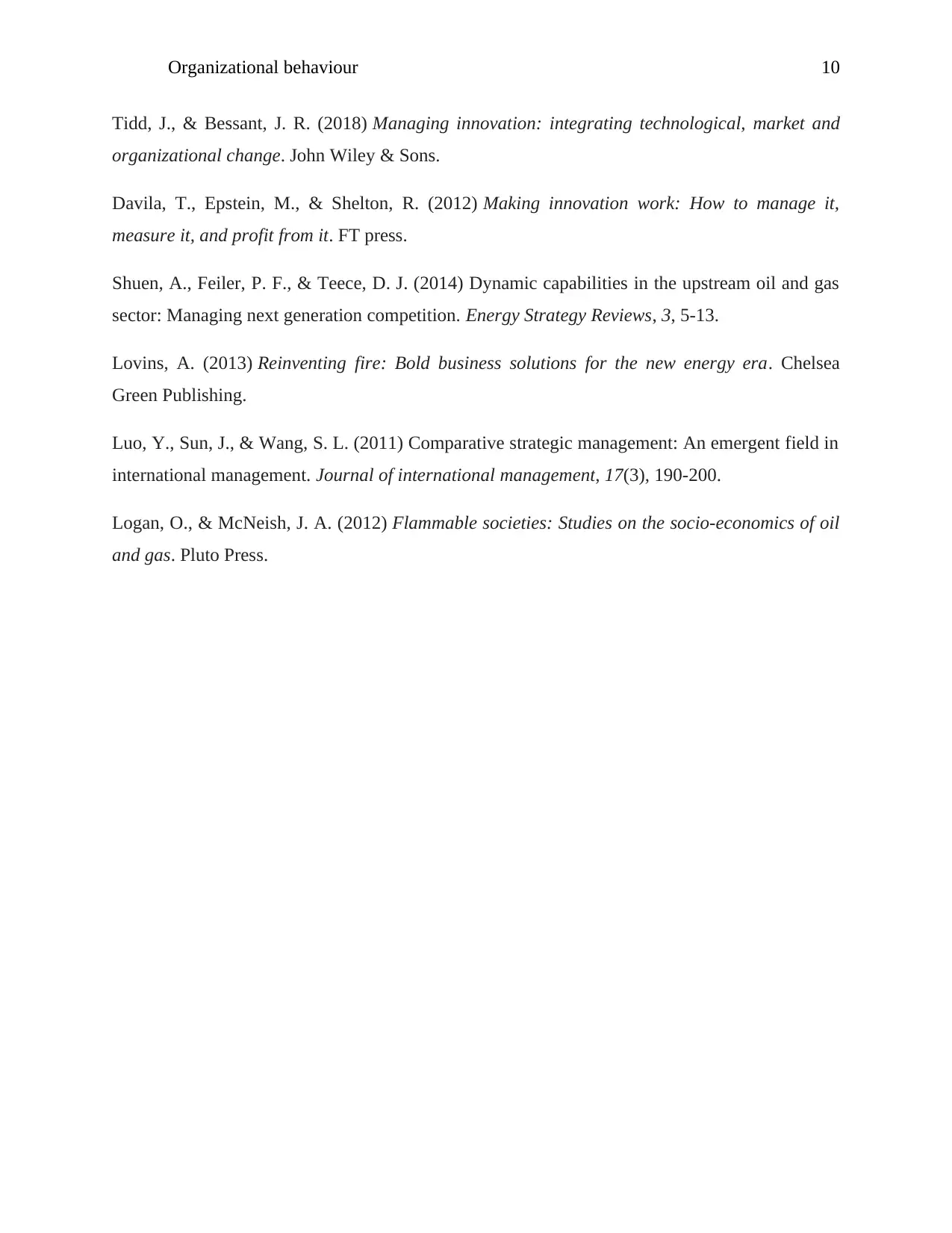
Organizational behaviour 10
Tidd, J., & Bessant, J. R. (2018) Managing innovation: integrating technological, market and
organizational change. John Wiley & Sons.
Davila, T., Epstein, M., & Shelton, R. (2012) Making innovation work: How to manage it,
measure it, and profit from it. FT press.
Shuen, A., Feiler, P. F., & Teece, D. J. (2014) Dynamic capabilities in the upstream oil and gas
sector: Managing next generation competition. Energy Strategy Reviews, 3, 5-13.
Lovins, A. (2013) Reinventing fire: Bold business solutions for the new energy era. Chelsea
Green Publishing.
Luo, Y., Sun, J., & Wang, S. L. (2011) Comparative strategic management: An emergent field in
international management. Journal of international management, 17(3), 190-200.
Logan, O., & McNeish, J. A. (2012) Flammable societies: Studies on the socio-economics of oil
and gas. Pluto Press.
Tidd, J., & Bessant, J. R. (2018) Managing innovation: integrating technological, market and
organizational change. John Wiley & Sons.
Davila, T., Epstein, M., & Shelton, R. (2012) Making innovation work: How to manage it,
measure it, and profit from it. FT press.
Shuen, A., Feiler, P. F., & Teece, D. J. (2014) Dynamic capabilities in the upstream oil and gas
sector: Managing next generation competition. Energy Strategy Reviews, 3, 5-13.
Lovins, A. (2013) Reinventing fire: Bold business solutions for the new energy era. Chelsea
Green Publishing.
Luo, Y., Sun, J., & Wang, S. L. (2011) Comparative strategic management: An emergent field in
international management. Journal of international management, 17(3), 190-200.
Logan, O., & McNeish, J. A. (2012) Flammable societies: Studies on the socio-economics of oil
and gas. Pluto Press.
1 out of 11
Related Documents
Your All-in-One AI-Powered Toolkit for Academic Success.
+13062052269
info@desklib.com
Available 24*7 on WhatsApp / Email
![[object Object]](/_next/static/media/star-bottom.7253800d.svg)
Unlock your academic potential
Copyright © 2020–2025 A2Z Services. All Rights Reserved. Developed and managed by ZUCOL.





